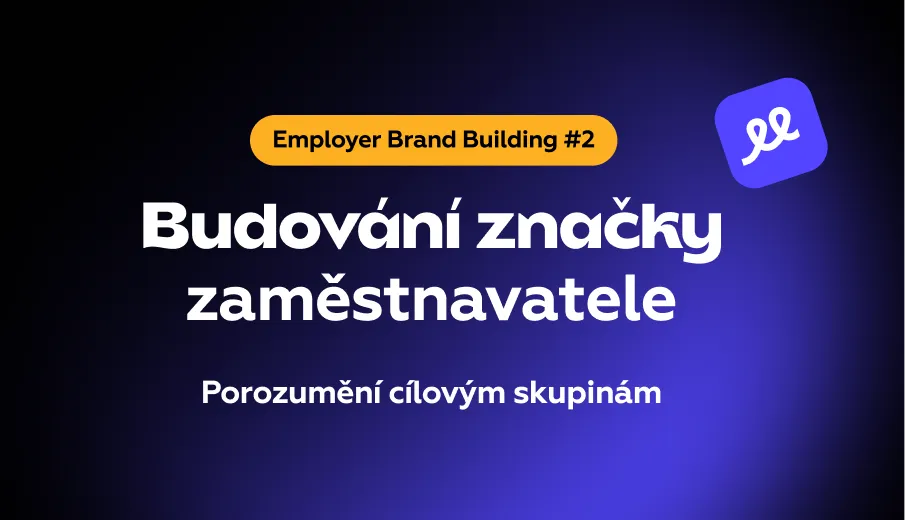Employer Branding #2: Understanding Your Target Audiences

Effective employer branding starts with a thorough understanding of your target audiences. It’s not just about job candidates — it’s also about current employees, internal stakeholders, and the broader public, including customers and partners. Each of these groups has different needs, expectations, and motivations – and understanding them allows you to communicate far more effectively.
Different Groups, Different Needs
In HR, we work with several key audiences, each requiring a specific approach.
- Candidates are primarily interested in what the company can offer them. They’re looking for clear information about benefits, company culture, and growth opportunities. Before making a career change, they carefully compare offers from various employers and seek out references. That’s why they need transparent and compelling reasons to choose your company.
- Current employees already know what it’s like to work with you, but they need to feel involved and see a future in the company. It’s essential that the reality matches what was promised during the recruitment phase – inconsistencies between expectations and reality seriously undermine trust and loyalty. A satisfied employee becomes your most valuable brand ambassador, speaking positively about your company and recommending it to others.
- Internal stakeholders, including leadership, managers, and colleagues from other departments, significantly influence your HR work. They co-decide on budgets, hiring strategies, and company culture, and their support is key to what kind of conditions you can offer candidates and employees. Effective communication with them should emphasize the business impact of your HR initiatives and support the company’s overall vision.
- Customers and external partners notice how you treat people, which in turn shapes how they perceive your company. According to the 2024 Edelman Trust Barometer, 78% of consumers consider how a company treats its employees an important factor when making purchasing decisions — although it’s fair to admit that price is ultimately the deciding factor.
Segmentation – A Path to Better Targeting
Segmentation means dividing your audiences into smaller subgroups based on selected criteria. This helps you better understand their specific needs and tailor your approach accordingly. The most effective strategy is to combine various types of segmentation that, together, give you a comprehensive picture of your target groups.
- Demographic segmentation considers factors like age, education, or place of residence. This helps you choose the right recruitment channels — you’ll target recent graduates differently (for example, via universities or Instagram) than experienced professionals (perhaps via LinkedIn or industry conferences).
- Generational segmentation is a variation of the above and lets you address the different expectations of age groups. For instance, Gen Z expects high flexibility and a digital work environment, while Gen X may value stability and a clear career path more.
- Psychographic segmentation focuses on interests, lifestyle, and values. It helps you understand people’s real motivations, which often go beyond basic demographic traits. Some people seek work-life balance, while others prioritize career growth. Some value exciting projects, while others prefer the stability of a large organization. These psychological factors often determine whether a candidate feels comfortable at your company — and whether they’ll stay.
- Behavioral segmentation looks at how people act and where they engage. Some candidates actively follow job portals and social media, others rely on personal recommendations or prefer in-person meetings at job fairs. Active candidates behave differently from passive ones — the latter being the majority. According to a LinkedIn study, as many as 70% of potential candidates are passive — they’re not actively looking for a job but are open to new opportunities. That’s why you need different strategies for those actively seeking a job and those who are open to change but not actively searching.
- Employer branding isn’t just a marketing activity. It’s a strategic process that connects company values, culture, and business goals with how you’re perceived by employees, candidates, and the broader public. At the core of this process lies authenticity – the alignment between what you communicate externally and the internal reality of the organization. This alignment is crucial because both candidates and employees now actively verify whether company promises match the actual experience.
Personas – Give Your Target Groups a Face
A persona is a fictional character representing a typical candidate or employee. It’s not just about demographic data — a persona has its own motivations, concerns, and expectations from an employer.
This allows you to communicate much more personally and accurately. Instead of saying “we’re looking for a developer,” you can speak to “Peter, 28, who wants to work with new technologies and grow in a modern company.”
Creating an effective persona requires a combination of data and empathy. Use existing data about your top employees, conduct interviews with various team members, and analyze feedback from recruitment processes. A well-crafted persona should include demographic details, career goals, personal motivations, a typical day in their life, communication preferences, and key decision-making factors.
The more realistic the persona, the better it will support targeted communication.
You can use personas both in recruitment and internal communication. In recruitment, you can craft job ads that speak directly to your target persona: “Do you want to see the results of your work in real time? Do you enjoy working with new technologies? Join our team where…” In internal communication, you’ll know, for example, that a specific persona is interested in education and development, so you’ll present training, mentoring, or new project opportunities directly to them.
The Employee Journey – From First Contact to Long-Term Collaboration
In marketing, we talk about the “customer journey” – all the stages a person goes through before and after making a purchase. In HR, it’s very similar – the “candidate journey” or “employee journey” follows the same principle. Candidates and employees go through various phases, each with different needs.
- The consideration phase is the first step, where a potential candidate starts thinking about changing jobs. At this stage, people often search for information about different employers, read reviews, and follow career pages on social media. Your task is to be visible with relevant content that addresses their concerns and highlights the benefits of working at your company. Stories from current employees, company leadership (CEO or brand representative), videos from the workplace, or articles about company culture can significantly influence their decision at this stage.
- The active search phase is when candidates are actively looking for new opportunities. They search for specific positions, compare benefits, salaries, and company cultures. At this point, it’s essential to have clear and attractive job listings, an intuitive career site, and a strong presence on job boards. Don’t forget that reviews from current and former employees play a big role in this phase — candidates actively seek them out.
- The decision phase is a critical moment when the candidate compares offers, asks friends for references, and weighs the pros and cons. Candidate experience plays a decisive role here — how fast and professionally you communicate, the impression made during the interview, and the transparency of the entire process. According to an IBM study, as many as 58% of candidates reject a job offer due to a poor experience during the recruitment process, even if the position itself is attractive.
- The onboarding and adaptation phase begins when a new employee joins the company and gets to know the environment, colleagues, and work processes. Quality onboarding is crucial — companies with a well-designed onboarding process see up to 62% higher productivity in new hires during the first months and 50% higher retention after the first year. This stage is not only about practical information but also about building social connections and understanding company culture. And don’t underestimate the cost — we sometimes assume that parting ways with a new hire after four months costs the equivalent of four monthly salaries. Wrong. You lose all the investments made: time, energy, resources, hope, expectations. All of that is money. And not a small amount.
- The growth phase is a long-term process in which the employee develops their skills, engages in projects, and potentially moves into more senior roles. The key here is to offer opportunities for learning, career advancement, and meaningful work. Regular feedback, recognition of achievements, and a clear vision of future development help maintain motivation and engagement. According to a Deloitte study, companies that actively support employee development see up to 37% higher productivity and are 58% more likely to attract top talent.
Understanding these phases enables you to create personalized communication and support for every step of the employee journey. A satisfied employee who has a positive experience throughout all phases becomes your strongest marketing tool – recommending the company to friends, speaking positively on social media, and contributing to a strong employer brand.
The better you understand your target groups and their needs, the more effectively you can work with them. Investing in a deep understanding of your candidates and employees is the foundation of successful employer branding and effective HR communication.
In the next part, we’ll take a closer look at internal communication.
This series is created in kind collaboration with the Association for Strategic Communication and Public Relations.




